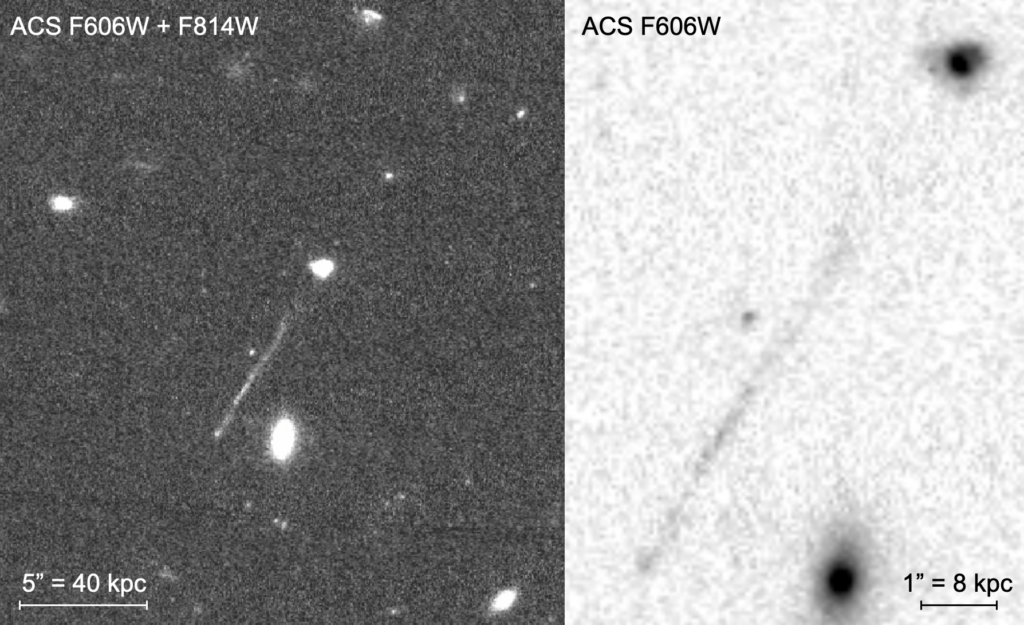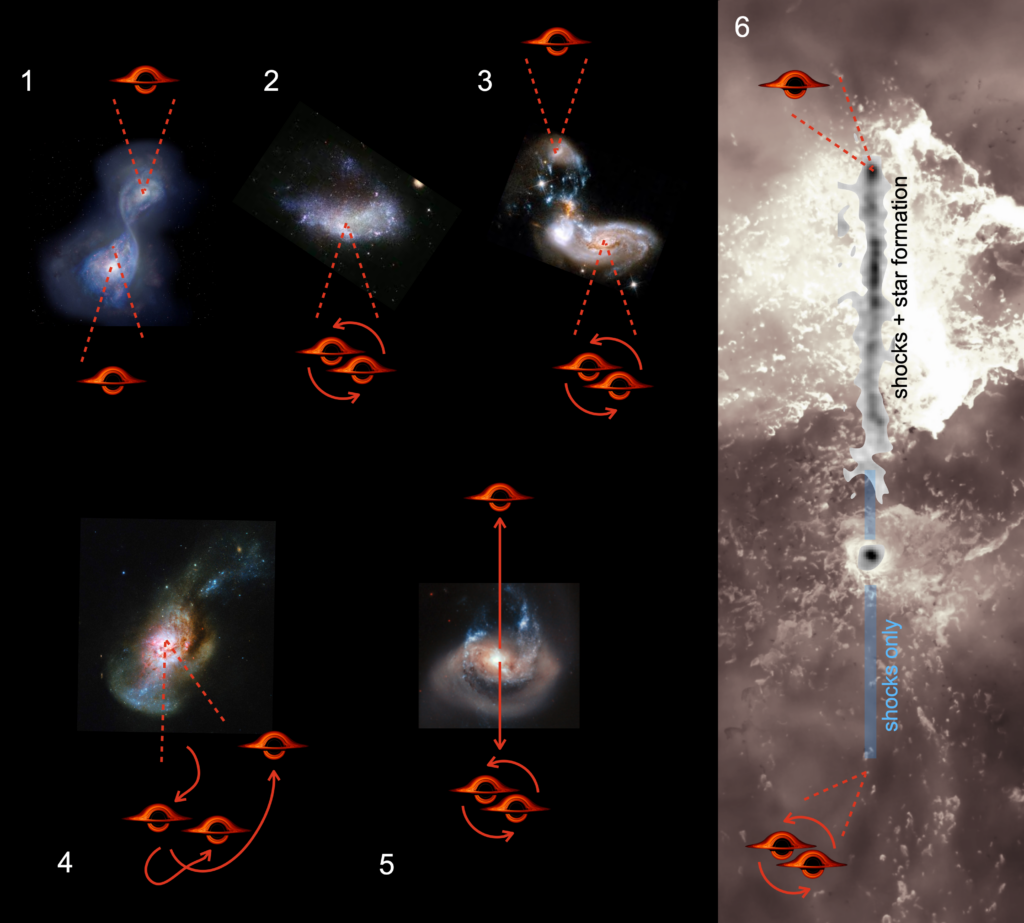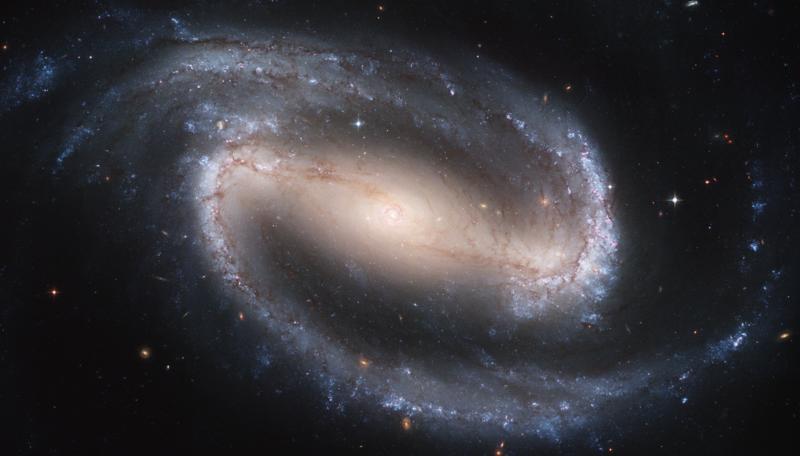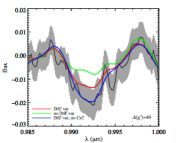Title: A candidate runaway supermassive black hole identified by shocks and star formation in its wake
Authors: Pieter van Dokkum, Imad Pasha, Maria Luisa Buzzo, Stephanie LaMassa, et al.
First Author’s Institution: Yale University
Status: Accepted for publication in The Astrophysical Journal Letters
In the heart of a distant galaxy, two supermassive black holes (SMBHs) have been locked in a pitched battle for billions of years. Entire star systems are muscled aside as the two black holes circle around each other, each sizing up the other as potential prey. They spiral slowly inward, their gargantuan footfalls kicking the space-time into ever more fervent foams. It is only a matter of time before they finally collide, their final blows bleeding out more energy than all the stars in the Universe combined.
But before this can happen, an interloper appears. A third supermassive black hole enters the fray. In the chaos, momentum is exchanged. The two most massive black holes manage to throw out the lightest one, but at what cost? Conservation of linear momentum means they, too, are ejected. The smaller SMBH and the comparative behemoths are flung in opposite directions, each flying far far away from the galaxy they were dueling over. In their wake, gas lights up, set afire by the shock waves. As the wake closes behind the smallest one, the gas condenses. It flies on towards infinity, leaving behind a twinkling trail of stars.
According to today’s paper, something like this actually happened…
Hot on the Trail of a Trail
The authors of today’s paper were stunned when they discovered a mysterious object in their Hubble images: a linear streak, seemingly leading away from the galaxy RCP 28 (see Figure 1). The fact that it appeared in multiple images under different settings meant the feature was real and not a cosmic ray strike. But what was it?

The authors describe their further investigations of the streak’s properties using multiple observatories. Observations with the LRIS instrument on Keck revealed the streak had strong emission lines atop a stellar continuum (especially the line from doubly ionized oxygen, [O III]). It terminates in a bright knot of emission the authors label A (Figure 2). Observations with the Canada France Hawaii Telescope (CFHT) reveal the trail is also luminous in the far-UV. A fainter streak of [O III] is observed on the opposite side of the galaxy, as well as UV emission (see Figure 2), though no visible continuum emission is observed. This counter-streak terminates in a feature the authors call B.

The original streak also shows strong variations in color (Figure 3), with oscillations between redder and bluer colors visible as you move your eye down the streak, suggesting that the stars creating the continuum emission are different in different parts of the streak. The combination of [O III] emission and far-UV emission suggests that the original streak and the counter streak are ionized by shock waves. This suggests the trail is created by something that is moving very fast.

What could be the identity of these streaks or trails? They cannot be a gravitational lens, as RCP 28 is at the same redshift as the streaks. They cannot be extensions of RCP 28, as then the counter-streak should contain stars as well as the main streak. But the counter-streak does not show the continuous blackbody emission of stars; it shows emission lines only. The shocked gas is also inconsistent with the streaks being part of the galaxy; if they were simply part of the galaxy, they wouldn’t be moving fast enough to create shock waves. The streaks could be jets from an active galactic nucleus (AGN) in RCP 28, creating shock waves in the gas surrounding the galaxy, with star formation triggered by the jet in the main streak. This is unlikely, however, because RCP 28 does not show signs of an AGN, and the main streak is narrowest at its tip far from the galaxy, and widest at its base near the galaxy. AGN jets start out as narrow beams in the core of a galaxy, and expand wider as they travel away from the galaxy. The streaks therefore have the opposite shape of a jet.
Footprints Made of Stars
Having ruled out all other explanations, the authors posit the unimaginable: that the streaks are due to supermassive black holes that have been ejected from RCP 28. The only thing big enough to move an SMBH is another SMBH, so they hypothesize that a three-body interaction occurred between three such monsters in the center of the galaxy. These chaotic interactions can occur when two galaxies merge and then a third one merges with them later. The SMBHs from the first two galaxies pair up into a binary, and then interact with the SMBH from the third galaxy. Typically what happens in these scenarios is the two most massive SMBHs become a new binary, while the smallest SMBH is ejected away at high velocities. The new binary also receives a recoil kick in the process, though due to its greater mass, it moves more slowly.
Theoretical models predict an SMBH racing through the gas surrounding a galaxy would trigger shocks that induce star formation in its wake. In addition to the stars that are born due to its passage, the SMBH is expected to drag along with it some stars from the center of its former galaxy, creating what’s known as a hypercompact stellar system.
The authors posit that the mysterious linear streak and its counter streak are the shocked gas wakes left behind by ejected supermassive black holes (Figure 4). The counter streak is fainter and shorter because it is created by the slower-moving binary, while the main linear feature is brighter and faster because it is created by the faster-moving third SMBH. The main streak has stars forming in it as a result of compression by the shocks. The variations in color along the streak occur because massive stars cycle between blue and red supergiant stages as they age. Objects A and B are candidate hypercompact stellar systems: the unfortunate stars torn from their galaxy by the immense gravity of the runaway black holes.
If the authors’ conclusions are correct, this is the first known detection of a wake left behind by a recoiling supermassive black hole. We may not have witnessed the unfathomable fury of the clash of titans, but we can observe the battle scars.

Astrobite edited by Mark Popinchalk
Featured image credit: Lynnie Saade





Wow, you made it super interesting, great job Lynnie
Thanks. As it says in my bio, I have a weird hobby of writing stories where the characters are celestial objects, so I tried to draw from that here. I’ve given a bit too much thought to the idea of what a black hole merger would be like from the black hole’s perspective (if you could imagine a black hole having one)
What a nicely written article!
Thank you, I’m glad you like it :3